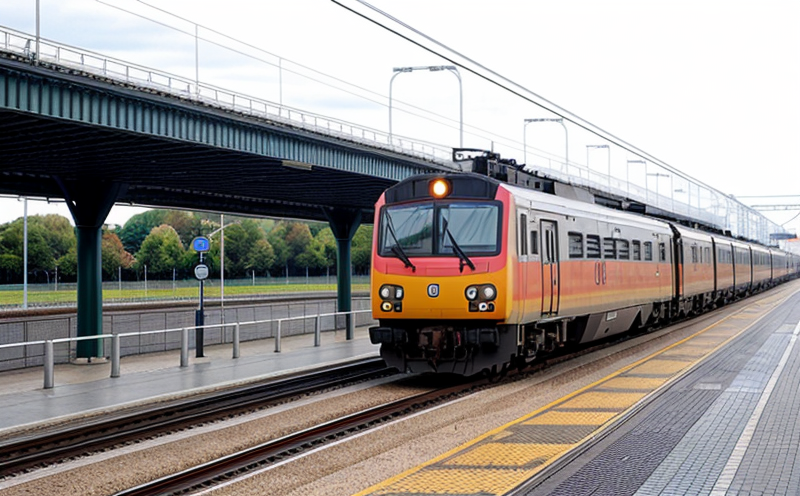ISO 3381 Railway Vehicle Interior Noise Measurement
The measurement of noise levels inside railway vehicles is critical to ensuring passenger comfort and meeting regulatory standards. The ISO 3381 standard provides a comprehensive framework for measuring interior noise in railway vehicles, which helps manufacturers optimize their designs and ensure compliance with international regulations.
This service focuses on the detailed procedures outlined in ISO 3381, including the measurement of sound pressure levels (SPL) within railway vehicles. The testing is conducted under controlled conditions to simulate real-world scenarios, ensuring accurate and reliable results. This process involves careful setup, precise instrumentation, and meticulous data collection.
The test procedure begins with preparing the interior environment of the vehicle. This includes removing any temporary obstructions or equipment that could affect sound propagation. Once the environment is set up, the noise measurement system is calibrated to ensure accuracy. The system consists of a sound level meter connected to microphones placed at strategic points within the vehicle.
The standard specifies the placement and number of microphones required based on the type and size of the vehicle. For example, in larger vehicles, multiple microphones are used to capture sound from different areas. The noise levels are measured over a specified time period, typically one minute, at various points during the test.
The results are then analyzed using statistical methods to ensure that they meet the acceptance criteria defined by ISO 3381. These criteria include limits for acceptable noise levels and guidelines for reducing noise where necessary. The data is reported in a detailed format that includes raw measurements, averages, and deviations.
Understanding these parameters allows engineers to make informed decisions about material selection and design changes aimed at reducing interior noise. By adhering to ISO 3381, manufacturers can ensure their products meet the highest standards of quality and passenger comfort.
The railway industry has been increasingly focused on improving passenger experience through better acoustic management. This service plays a crucial role in achieving that goal by providing accurate and reliable noise measurements. It helps identify areas where improvements are needed, thereby enhancing overall customer satisfaction and operational efficiency.
Industry Applications
| Application Area | Description |
|---|---|
| Railway Vehicle Design and Development | This service is essential for designers and engineers who are responsible for creating passenger comfort features. By measuring noise levels, they can identify areas where improvements are needed to enhance the overall passenger experience. |
| Compliance with International Standards | Railway manufacturers must comply with various international standards, including ISO 3381. This service ensures compliance by providing accurate and consistent noise measurements that meet these requirements. |
| Enhancing Passenger Comfort | The goal of this service is to improve the acoustic environment within railway vehicles. By reducing noise levels, manufacturers can create more comfortable and enjoyable travel experiences for passengers. |
| Optimizing Vehicle Design | Data collected from ISO 3381 tests are used by engineers to optimize designs. This includes selecting materials that have better acoustic properties, which can significantly reduce noise levels in the vehicle interior. |
Customer Impact and Satisfaction
The implementation of ISO 3381 railway vehicle interior noise measurement brings significant benefits to both manufacturers and passengers. For manufacturers, this service helps them stay compliant with international standards while also improving the quality of their products. By meeting these standards, they can ensure that their vehicles meet the expectations of regulatory bodies and consumers.
For passengers, improved acoustic environments lead to greater comfort and satisfaction. Quieter interiors contribute to a more pleasant travel experience, which is especially important in long-distance or overnight journeys. Passengers may also appreciate lower noise levels for health reasons, as prolonged exposure to high noise levels can be detrimental to one's well-being.
Manufacturers who invest in this service are likely to see increased customer satisfaction and loyalty. Positive feedback from passengers translates into better market reception and potentially higher sales figures. Additionally, compliance with international standards can open up new markets for manufacturers, as they demonstrate their commitment to quality and safety.
Environmental and Sustainability Contributions
The measurement of noise levels within railway vehicles also contributes positively to environmental sustainability. By reducing interior noise through optimized design, manufacturers can contribute to a quieter urban environment. Lower noise levels in transportation systems can lead to reduced stress for commuters and improved air quality.
Furthermore, the use of this service aligns with broader sustainability goals by promoting efficient resource management. Quieter vehicles may also operate more efficiently, potentially leading to lower energy consumption and emissions. This not only benefits the immediate environment but also supports long-term environmental conservation efforts.





